#best train journeys in india
Explore tagged Tumblr posts
Text
In this post, there is a list of some luxurious trains in India that will not only take you to your destination but also make your journey memorable.
#train journeys in india#luxurytrailsofindia#cheapest luxury train in india#best train journeys in india#india railway tours#train trips in india
1 note
·
View note
Text
https://www.goldenchariot.org/golden/indian-railway-journeys-south-india/
This award-winning train provides an opportunity to discover famous South Indian destinations through unique travel experiences. The Golden Chariot offers well-designed Indian railway journeys that will make your entire tour enjoyable and comfortable. Itineraries covered by Golden Chariot range in length from 4 to 6 days. The train will transport you back in time with lavish train journeys that showcase the diversity of South Indian states in the shortest amount of time. This luxury train's itineraries include heritage, wildlife, nature, spectacular palaces, and a luxurious touch.
#luxury train tours in South India#Indian railway journeys#best train journeys in India#The Golden Chariot#indian railway journeys south india#besttrainridesinindia#touristtrainsinindia#bestluxurytraininindia#royaltouristbangalore#goldenchariotroute#goldenchariottrainbooking#GoaTrainTour#luxurytouristtrainsouthindia#indianrailwayjourneyssouthindia#luxurytraininindiafare#mostluxurioustraininindia#traintourpackages#goldenchariotfacilities#bangaloregoaluxurytrain#indiabesttrainname#goldenchariotfare#goldenchariottrainbangaloretogoa#goldenchariotindia#goldenchariottrainindia#thegoldenchariottrainroute#goldenchariottrainroute#goldenchariottrainpriceforindian#goldenchariottrainpriceinindia#thegoldenchariottrainrouteandfare#goldenchariotonlinebooking
0 notes
Text
Ayuryoga Academy | Best Yoga Teacher Training Rishikesh
Are you interested in becoming a professional yoga trainer? Join the best yoga teacher training in Rishikesh, the Ayur Yoga Academy. Our unique blend of traditional yoga practices, holistic teaching methods, and a serene environment make us the ideal choice for those seeking to deepen their practice and become certified yoga instructors.

#yoga#yoga aesthetic#yogadaily#yogainspiration#yogalife#yogaposes#yogapractice#mental health#healthcare#health & fitness#fitness#spirituality#spiritual healing#spiritualism#spiritual awakening#spiritual journey#best yoga teacher training in rishikesh#best yoga teacher training in india#yoga instructor
3 notes
·
View notes
Text
youtube
#youtube#tumblr#viral#vlogging#daily vlog#facebook#solo#whatsapp#best#trending#instagram#tiktok#bangladesh#india#asia#europe#africa#travelling#public transport#travel#local travel#tourist#tour#tourism#train journey#bus journey#journey#village#nature#urban
0 notes
Text
India Calling: Explore the Best railway Journeys with IRCTC Tourism
Train trips are the finest way to discover the best of India’s culture, history, and natural landscape. If you want to discover the best railway journeys then there is no better option than the multiple travel packages by IRCTC Tourism.
Railways – Gateway to an unforgettable journey
IRCTC holiday packages are best suited for those who love adventure, want to leave from the thronging hordes and look forward to a sojourn of the varied topography of the Indian sub-continent. Whether it is the vibrancy of the busy towns or the quiet solitude of the spiritual abodes, the best train trips offer a unique experience that is nowhere else to be found.
Another exciting feature is that comfortable seats and mouth-watering food during the journey make it an experience much more like staying in a high-class hotel on wheels. Check out the best packages for train travel in India and book your dream train trip fast. The journeys are going to rejuvenate your soul, passing through rivers, mountains, plains, deserts, and waterfalls.
Exploring India: The Best Train Vacations with IRCTC Tourism
IRCTC Tourism covers the best domestic tours in India with the help of multiple tour packages. Travelling with IRCTC Tourism offers many benefits that make the entire journey an enriching experience. The first is the convenience and comfort of its well-arranged travel packages, including tickets for the train, accommodation, meals, and guided tours.
This proves to be a hassle-free experience altogether. Indeed, IRCTC also has budget packages to make train travelling more feasible for every tourist's budget, whether one is a backpacker or prefers luxury.
Trains are also a mode of travelling wherein people can get a glimpse of the vast varieties of landscapes in India and get acquainted with the locals. This will undoubtedly boost their knowledge about India's diverse cultural traditions. Also, it is a safe and reliable platform for finding the best tour packages. The tour will be handled by professionals who ensure a safe and sound experience for the travellers. Some of the best train vacations that you can avail through IRCTC Tourism are:
The Golden Triangle Tour
It takes travellers through the lively cities of Delhi, Agra, and Jaipur, offering them an insight into India's rich heritage. The main attraction includes a visit to the enchanting and wondrous Taj Mahal, a UNESCO World Heritage site. In Delhi, visitors can explore the Red Fort, a symbol of Mughal architecture, before heading to Jaipur to admire its architectural marvels.
The Kerala Backwaters
This tour gives travellers a chance to witness the serene beauty of this enchanted land. Alleppey is the place where visitors catch a glimpse of quiet waters, lush green surroundings, and charming villages with the best railway journeys. Munnar is a beautiful place where, on the hills, tea plantations sweep across with the glimpse and taste of the region's scrumptious tea.
South India Temples Tour
This tour takes you to places which are full of history and majesty. Some of the great experiences include visiting the magnificent Meenakshi Temple in Madurai, renowned for its intricate work and vibrant sculptures that form the basis of Tamil Nadu's rich cultural legacy. Padmanabhaswamy Temple and some other temples are also some of the major attractions in South India that you must visit.
Conclusion
The train tours by IRCTC Tourism can be reckoned as the best train trips which offer a unique glimpse into the heart and soul of the country. The portal is packed with amazing deals and myriad packages that will suit every kind of traveller. Make memories of a lifetime with these vacations and explore the best travel domestic tours in India.
Source: https://sites.google.com/view/india-calling-explore-the-best/home?authuser=4
0 notes
Text
The Top 10 Best Trains in India
There is no doubt that the Indian Railways is one of the most popular ones at the moment, and hence there are newer additions to the list as well. Check out the ten best trains in India in this article. If you happen to go around the world, the one thing that you will notice for sure is that the name of Indian railways is quite popular. One of the most important reasons behind the same is that…

View On WordPress
0 notes
Text
The top 5 luxury trains of India, including Palace on Wheels, Maharaja's Express, Deccan Odyssey, Golden Chariot, and Royal Rajasthan on Wheels offer routes to most sought-after destinations.
#luxury trains of india#luxury trains journey#luxury travel#indian luxury trains#luxury train tours in india#luxury tours#best luxury tours
0 notes
Note
ok so i am very much uninformed on politics, i decided at a younger age that i wasn't interested in it and therefore would not read or keep myself particularly informed about it. obviously this is a bad idea, and i want to change and keep myself informed on actual politics and well, abstract[?] (wrong word but cannot think of another, basically mean like. knowing which political .. stance ?? [idk. like marxist or communist or whatever] i might be.) ones as well. what's a good place to get started here? where do i look for actual politics going on in india since i'm pretty sure ndtv or whatever isn't exactly the best source? or maybe it is? idk, like i said i'm pretty uninformed on the matter but would like to learn more
so one thing is, in india you have to accept the media landscape is just dire because being a journalist with integrity is a bit like signing up to have your life ruined. all major media has been bought by hindutva already. what you have to do is more learn to read between lines, understand people's motivations, which is a matter of practice. a good way to start is to read analysis (not news reports) of the same incident in different media and you'll start noticing patterns. even more important imo is to talk and bounce ideas with a friend at a similar place as you or someone interested in politics who won't overwhelm you with their perspective. you can try online but idt its safe or advisable anymore to do that experiment online. i had debate club in university (sad) and some socialist reading groups (better) after. the thing is this journey to self education is kind of personal and im also not pedagogically oriented or trained? so lots of first person description instead of prescriptions.
i still check what's up on ndtv because it gives me a good pulse of what english language media and liberals are thinking. major newspapers i scan hindu and the indian express sometimes. online i have a look at newslaundry (also has some youtube content) and the wire, they're reader supported and haven't turned full hindutva yet. i read longer form things in the caravan and epw, but these are subscription based. i keep tabs on the latest round of hindutva fake news when alt news debunks it.
for the abstract things, i literally did an online course bc i was frustrated by what all the liberal arts grads seemed to already agree on. i did ian shapiro's moral foundations of politics which is available online as both youtube lectures and a textbook. if you want to go that route feel free but it's not necessary, you can also try to read the entries on wikipedia or stanford encyclopedia of philosophy (more expertise) when you encounter something unfamiliar and build up like that. podcasts like bbc in our time will often interview academics to give intros to many political philosophy concepts and thinkers. whatever your learning style supports! i think the important thing is to find something you are actually interested in, and take that tack. i like history, so i might read books about historical revolutions or historical forms of organising society or listen to podcasts like mike duncan's revolutions.
For communism the usual starting points are these very short pamphlets:
Principles of Communism by Engels
The Manifesto of the Communist Party by Marx
Wage-Labor and Capital by Marx
Socialism: Utopian and Scientific by Engels
feel free to ask for more specific questions!
149 notes
·
View notes
Text
JTTWR Story Idea Directory
I was influenced by @digitalagepulao's recent post to list my own collection of story ideas.
These are set in the Buddo-Daoist disc world system of the original novel.
1) The Origin of Sun Wukong
This provides three fictional origins for the Monkey King based on my past research. He is ...
The spiritual offspring of supreme ape immortals who have served as teachers of countless mortal and divine beings, the later including the Buddha and Master Subodhi. The couple rebels against the heavenly hierarchy for failing to keep an ancient promise.
The offspring of an ancient evil who intentionally bred him to destroy the gods.
A former hot-tempered, Vajra warrior-like Bodhisattva who is exiled from paradise for killing a being who seemingly offended the Buddha. He is punished to ten lifetimes as a figure of great strength who is continually bested and forced by circumstances to protect something or someone weaker than him.
Each origin has pros and cons.
2) Immortal Warriors and Shaolin Monks
Master Subodhi's mountain is the training ground for an immortal monastic army similar to Shaolin. Monkey gains combat experience as a monk soldier.
3) The REAL Reason Subodhi Expels Sun Wukong
Sun's much, much older spiritual brothers and sisters attack him out of jealousy for quickly climbing the ranks of the immortal monastic army. Forced to defend his position, Monkey's anger drives him to take on a monstrous, 100,000-foot-tall cosmic form to defeat his opponents. Subodhi fears Sun's limitless potential and great anger will lead him down the path of villainy, so he uses the pine tree incident as an excuse to expel him.
4) The Reason for Sun Wukong's Rebellion
Subodhi warns Monkey to protect himself when mastering the "Multitude of Terrestrial Killers" (i.e. the 72 changes) because said deities are considered baleful stellar gods who bring bad luck and disease. But the Terrestrial Killers exploit a chink in his spiritual armor and feed him small suggestions that have compounding effects on his personality, making him increasingly egotistical and combative. This eventually leads to his rebellion against heaven.
These are set on our Earth.
1) Sun Wukong vs Heracles/Hercules
Heracles, the Buddha's protector, is called in place of Erlang to end Monkey's rebellion. After the latter attains Buddhahood at the end of the journey, the Tathagata asks the son of Zeus to escort Sun through the Greek world system.
See the 07-08-22 update (refer also to section 3 for background info):
2) A Realistic Retelling of Journey to the West
The story follows the itinerary of the historical monk Xuanzang, and the various episodes from the original novel take place both on the way to and coming back from India. The disciples are acquired during the initial journey; however, their order is reversed—Sha, Zhu, and then Sun.
The past punishments of the disciples are still the same. But Monkey's history is changed because Taoism didn't exist in ancient India. Instead of becoming an immortal, he is a Hindo-Buddhist rishi who rebels against heaven.
See updates here and here.
#Sun Wukong#Monkey King#Journey to the West#JTTW#Zhu Bajie#Zhu Wuneng#Sha Wujing#Sha monk#Sandy#Pigsy#Tripitaka#Xuanzang#alternate universe#lego monkie kid#buddhism#taoism#daoism#Hinduism#Chinese mythology#Hindu mythology#Buddhist mythology#Greek mythology#Hercules#Heracles#story ideas
91 notes
·
View notes
Text




Ahsoka Tano: Marvel verse Born: 1967, August 14th Childhood: -Between ages 0-14: The mutant daughter of the ambassador from India to the United States Pav-ti Tano was her mother, and her father Nak-il Tano of Ghanaian-Indian decent, was a Ghanaian Military General, and head of Upon finding out that Ahsoka's uncle, her father's brother, had been promoted to the head of Ghana's Weapon X program, Ahsoka's parents discussed how to best protect their daughter and decided that Ahsoka's mother should take her on a journey, knowing that the X-gene was in her genetics. They stopped at many temples of different beliefs, Hindu, Yogi, Buddhist, Tibetan Buddhist, and Taoist, to name a few, trying to help teach Ahsoka how to better control herself, just in case her X-gene would activate. Her uncle would eventually pursue Ahsoka and her mother, finding them in Shinto temple in Kyoto, Japan, while trying to learn the secrets of the ancient Onmyoji. Ahsoka's uncle, using a strike team of mutants from his program killing Ahsoka's father in front of her and her mother, but Ahsoka's mother helped her escape. They made it to Nepal, but they were pursued by the strike team who killed Ahsoka's mother when they caught up to the mother and daughter. This was all by the age of three, and this stress at such a young age caused Ahsoka's mutation to activate. A blast of emotional energy erupted from Ahsoka, causing the strike team to fly back, with force of an explosion, and become irrationally afraid, feeling Ahsoka's fear. A nearby passing monk saw the confrontation and took Ahsoka to the Kamar Taj, where she was trained to better control her psychic abilities. Over time white tendrils, with blue tiger-like markings, grew from her head, replacing her hair, giving Ahsoka the ability of echo location and being able to see people even within pitch black lighting, she learned to hone her psychic abilities and could sense those around her through telepathic and Psychic Empathic abilities.

mutuals may interact / reblog. -℘ɛŋŋɛɖ ცყ Naki Nɔki

#headcanon#oc lore#au lore#ahsoka tano#marvel verse#fulcrumredeemed#origin story#ooc#ooc post#-penned by naki#mutuals may interact / reblog.
9 notes
·
View notes
Text
7 comfort movies, 7 tags
I was tagged thirty thousand years ago by the lovely @giorgiaink, whose list is over here! Thank you for the tag and for the patience xD
This Is Not What I Expected (China, 2017. dir: Derek Hui Wang-Yu) When a grumpy hotel executive finds that his favourite food is cooked by the cook that ruined his car, he is conflicted on what to do to their kitchen. I absolutely love how silly this movie is, and the romance is very fun as well!
Jab We Met (India, 2007. dir: Imtiaz Ali) A depressed businessman meets a happy-go-lucky woman on a train and helps her finding the man she loves. This is everything to me. I almost watched it twice in the same day once. There is a shot of a train made with a toy in stop motion and it's iconic. There is a song sung under the rain. I absolutely love it.
Tre uomini e una gamba [Three Men And A Leg] (Italy, 1997. dir: Massimo Venier, Aldo, Giovanni e Giacomo) Three men leave for a journey from Milan to Gallipoli, in Puglia, where one of them has to get married. They are given the task to bring a piece of art to their father-in-law: a very expensive wooden leg. In the journey, they meet many disadventures, and a new companion. I know this movie by heart. At one point in my high school class, we only talked using its references. The sketches inside the movie are still iconic, as well as the ending.
The Emperor's New Groove (USA, 2000. dir: Mark Dindal) Ma certo, il veleno. Il veleno per Kuzco. Il veleno scelto appositamente per uccidere Kuzco. Kuzco e il suo veleno. Quel veleno? I know this movie by heart in two different languages. Next!
Howl's Moving Castle (Japan, 2004. dir: Hayao Miyazaki) I cannot explain this movie as well as I should. Only know that it's magical.
To Wong Foo, Thanks for Everything! Julie Newmar. (USA, 1995. dir: Beeban Kidron) A new entry in my comfort movie playlist! Three drag queens from New York leave for the grand final of a national beauty pageant, but their car breaks right next a small town. Here they teach the locals how to be themselves. Absolute joy.
Ferris Bueller's Day Off (USA, 1986. dir: John Hughes) When Ferris decides to skip school for the day, he takes his girlfriend and his best friend around the city to live adventures and to try not to think about what'll be of them after they'll graduate. I love the carefree energy of this movie, honestly it's something I would like to have as well at times!
If you're interested to see some more of my comfort movies, here's my list on Letterboxd.
I tag, as usual without any pressure, @2minutes2midnight, @agentofship, @the-eclectic-wonderer, @an-imaginary-raven, @woofety, @imlivingformyselfdontmindme, and @pollodigitale.
Thanks for reading if you did, and I hope you have a lovely day! <3
#tag meme#thank you!!#giorgiaink#non volevo metterci letteralmente 5 mesi per rispondere al tag#ma finalmente ho finito di mettere a posto la coda e i mi piace#e ho trovato il mondo li in mezzo lmao
15 notes
·
View notes
Text
Words by our Founders Oorjayii Yoga was created to provide a welcoming and safe space for people. We started with sharing circles and self-love yoga retreats, inviting healers and organizing workshops to promote balance, love, and mindfulness. Along the way, we noticed a growing disconnection in the world, especially due to modern lifestyles. Our vision expanded to include teaching yoga in schools, instilling kindness and mindfulness from a young age. As we progressed, we recognized the need for more teachers, or "Gurus," who could guide others out of darkness and into light. Our goal at Oorjayii Yoga is to train teachers who can facilitate personal growth. We offer individual attention, focusing on teaching skills, philosophy, anatomy, and the development of each person's inner teacher. The journey as a yoga teacher truly begins when one steps into the world to teach, whether for self-exploration or to guide others. Yoga brought a big change in both of our lives and that makes us more eager to bring change in other's lives who are in need of help. Any help to bring that change is always welcomed. You can reach us if you wish to be the part of our journey. We would love to hear from you :)
#yogastudent#meditation#yogaretreat#yogateachertraining#yogatraining#love#yoga#healthylifestyle#vinyasa#nature#yoga retreat#india#health & fitness#health#wellness#wellbeing#nutrition#beach#goa#spiritual practitioner#practice#yogi#yogini#personal
32 notes
·
View notes
Text
The price of the Golden Chariot train in India varies according to the itinerary, cabin type, and season of travel. As one of the most elegant train excursions in the country, the Golden Chariot provides a variety of luxury trip packages adapted to individual interests and budgets.
#expensive train journey in india#price of golden chariot train in india#best luxury train journeys in india#luxury trip packages
0 notes
Text
The Day of Days: Eighty Years After
It was a brisk summer night, almost like any other June night in England.
The terror of the Blitz was long over. Four years ago, the Battle of Britain long had been won. Two years ago in the Pacific the Americans had shocked the world with impossible victories at Midway and Guadalcanal. A year ago, the last German forces had surrendered in North Africa, and the Communists of the Soviet Union had done the impossible and stopped the German war machine in its tracks at the gates of Stalingrad and Moscow before, finally, turning the tide at Kursk. A month early the British Army in India had stopped the Imperial Japanese Army in its tracks at Kohima Ridge, and for the first time in three years the Japanese were on the run. Just a day before, the American Fifth Army had liberated Rome, freeing the "Eternal City" from fascism after twenty years.
They were winning - just. The war was still going on, ever-present in their minds, but they could sleep soundly under a quiet, friendly sky.
But in the dark, in army camps and airfields and naval bases and offices across the southwest of England, the scene was very different. Men whispered to each other, prayers and jokes, trying to lighten the tension in the air, so thick they could cut it with a knife. John Ford - the famed Hollywood director turned Navy Field Photographic unit captain - supposedly told his wife he was going off for a little local skirmish. And in his private office, Dwight D. Eisenhower - Commander, Supreme Headquarters Allied Expeditionary Force - typed the resignation he hoped he'd never have to give. If the unthinkable happened, if this gamble failed...they might never get another chance.
All at once, all across the southwest of England, just before midnight, the quiet was shattered by the roar of thousands upon thousands of piston engines, and thousands of men, some barely out of high school, clambered aboard planes and landing craft for a journey into the dark.
Eisenhower penned a short note, and ensured that a copy was given to every single one of the men under his command. It read, very simply:
"You are about to embark upon the Great Crusade, toward which we have striven these many months. The eyes of the world are upon you. The hopes and prayers of liberty-loving people everywhere march with you. In company with our brave Allies and brothers-in-arms on other Fronts, you will bring about the destruction of the German war machine, the elimination of Nazi tyranny over the oppressed peoples of Europe, and security for ourselves in a free world."
It was June 6th, 1944, and after three years of begging by Josef Stalin, and a year of intense planning, brutal training, unparalleled deception, and massive buildup, the time had come to do the impossible.
The Allies were going to break the Atlantic Wall, or die trying.
It was a herculean task. The Germans had spent four years preparing for just this day, filling every beach from Cherbourg to Amsterdam with every kind of mine imaginable, dotting Czech hedgehogs and wooden posts tipped with high explosives along the shallow coastlines, and building bunkers with encased machine guns and artillery, pre-sighting mortars and artillery, digging trenches and building tens of thousands of pillboxes, and digging enough anti-aircraft positions to turn night into day. In command was Erwin Rommel, the famed "Desert Fox", a veteran of the brutal World War I Italian front, and one of the best tank commanders in the world who had fought across France and North Africa. Under his command were almost half a million German troops, including battle hardened veterans of France, Africa, and Russia.
Standing against them, over a thousand planes and gliders carrying over 23,000 paratroopers from the United States, the United Kingdom, and Canada. Behind them, thousands of fighters and bombers and almost seven thousand landing craft and ships carrying more than 160,000 men from thirteen nations.
The Day of Days began just after midnight.
At 00:48 on June 6th, 1944, the men of the 101st Airborne became the first of to make a terrifying jump into the dark.
It was the beginning of the single largest amphibious invasion ever attempted. Six hours after the paratroopers took the plunge, at 06:30 local time, the first men stumbled onto shore, and into the jaws of death.
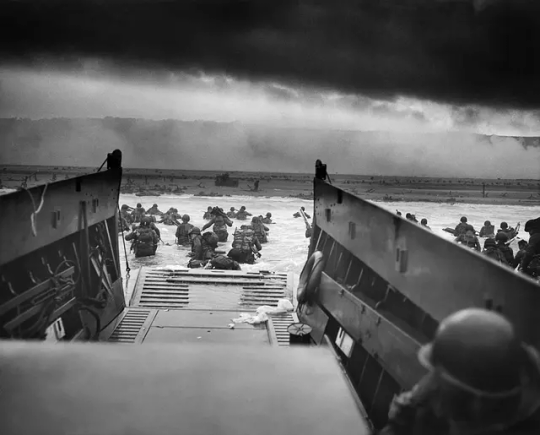

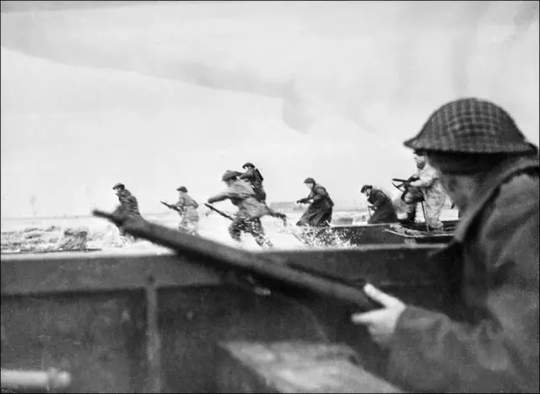
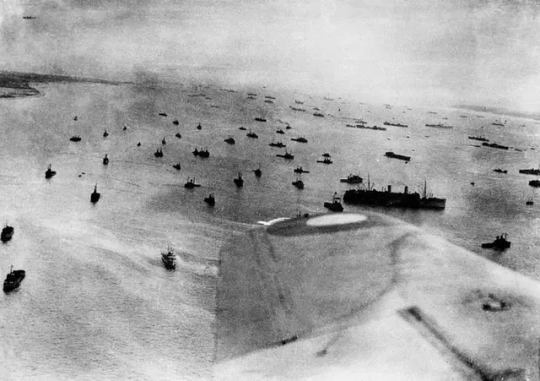

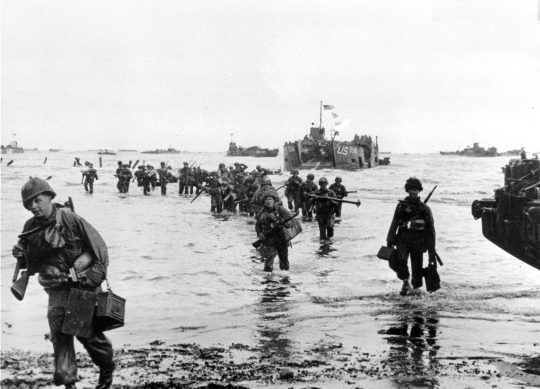
Almost immediately, the entire plan fell apart. Fog, cloud cover, a lack of navigators, and brutal anti-aircraft fire forced many pilots to signal the paratroopers to drop outside their assigned zones, mixing units and men and causing absolute chaos on the ground. The weather in the channel was not much better: high seas swamped many of the landing craft and amphibious tanks, and strong currents pushed entire regiments out of their landing zones.
When the men finally made it to the beach, they faced a desperate run across the dreaded shingle: a nearly half-mile expanse of open sand and rock, with no protection at all from the waiting German defenders. Their fire support - the naval vessels waiting offshore, bristling with guns of all calibers - was of little help; the captains refused to close any farther than the extreme ranges for fear of counter fire. And the bad weather in the skies above prevented pilots from accurate close air support.
Over ten thousand men from both sides would have their lives ripped apart on beaches in just that first day.
On Omaha Beach alone, almost two thousand men were killed. Some didn't even get a chance to face the enemy - instead, they simply drowned, their heavy equipment weighing them down into the cold waters of the North Atlantic. The beaches themselves, its said, turned red with blood as men were killed by the dozen. At Gold, Juno, and Sword Beaches, the Canadians and British managed to make it off the beach, only to be forced into fortified towns, where they endured the brutality and chaos of house-to-house urban warfare. At Pointe du Hoc, between Omaha and Utah Beach, the U.S. 2nd Ranger Battalion were forced to scale a one hundred foot cliff under withering enemy fire, only to become totally cut off. When they were finally relieved after two days, only 65 of the original 200 men were left standing, and they were forced to use captured German weapons as theirs ran out of ammunition, resulting in some of their number being killed due to friendly fire.
The paratroopers faired even worse - of the more than 20,000 American paratroopers and aircrew who made the desperate flight across the Channel, it's estimated that more than twelve thousand were killed.
The carnage was unlike anything anyone in the Allied forces had seen before, unlike Operation Torch or El Alamein in North Africa, unlike the Miracle of Dunkirk or the Battle of Britain, unlike Guadalcanal and New Guinea, unlike Salerno, Anzio, and Sicily.
For this untold sacrifice, this bloody hell that almost two hundred thousand men endured, they had only managed to capture a few square miles, only two of five beaches were connected, and they had failed to capture a single major city or port. The Allies failed to achieve even one of their major objectives - save one.
After five years of war, the Allies had a foothold.
The mother of all Hail Mary's had worked.
By the end of D-Day, almost 160,000 men had crossed the Channel into Fortress Europe.
On D+6, the beaches were finally connected.
On D+7, the city of Carentan was freed by the 101st Airborne, the first major French town to be liberated.
By D+20, the port city of Cherbourg was taken, and the Cotentin Peninsula was free after four long years.
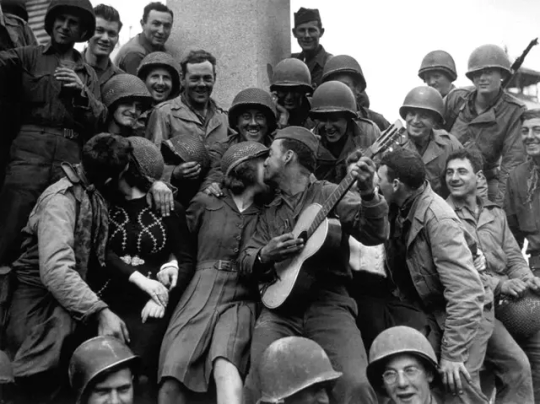
On D+50, the city of Caen was freed, and the objectives of D-Day had finally been completed. By this time, more than 1.5 million men from 15 nations had landed in Europe.
On D+70, the Allies landed on the beaches of Côte d'Azur, and in only four weeks broke the southern German front line, and liberated the entire south of France.
On D+76, the Falaise Pocket collapsed, and the Battle of Normandy was finally declared over in a resounding Allied victory.
Then, at long last, on D+80, General der Infanterie Dietrich von Cholitz, at 3:30 PM local time, surrended the city of Paris to General Phillipe Leclerc. After four years of occupation, the first Allied capital was free. The footage of that day has been called some of the most thrilling and ecstatic footage in history.


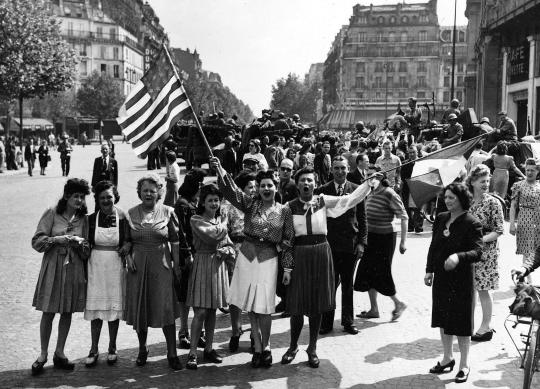
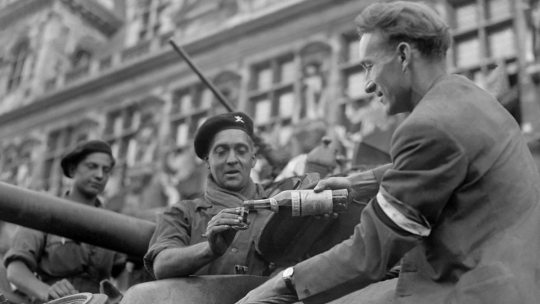
The march continued, and on D+89, the Welsh Guards marched into the Belgian capital of Brussels.
But the war was far from over - on D+193, the Wehrmacht launched Operation Nordwind; the Battle of the Bulge had begun. It would be Germany's last offensive, at the cost of hundreds of thousands of lives.
On D+274, the Allies crossed the Rhine, and liberated the Netherlands, and then finally entered Germany.
On D+303, the U.S. 4th Armored Division stumbled upon a scene of unimaginable cruelty: it was a camp named Ohrdruf, part of the Buchenwald complex, the first concentration camp to be liberated by the United States. Allied intelligence services had long suspected what was going on, that their were camps across Europe for Hitler's "undesirables", and the Allies had even signed a declaration making public and condemning the killing of Jews in Poland, but no one was prepared to see the true scale of the atrocities. Eisenhower demanded that every single piece of the camp be photographed, videotaped, and documented, that everyone possible be brought to see it to impress upon them the reality of what the Germans had done. Hollywood director George Stevens was given the task of making movies describing the horrors of the Holocaust, movies that were later shown to the world at the Nuremberg Trials. The movies were said to be the moment that changed the course of the Nuremberg Trials.
Then, on April 30th, 1945 - three-hundred and twenty eight days after the 'Longest Day' - Adolf Hitler, the man who had been the head of so much destruction, who had started the most destructive war in human history and presided over the worst genocide mankind has ever perpetrated, commits suicide in a bunker in Berlin.
Three days later, on May 2nd, 1945, the surrender of German Army Group C goes into effect, and the Gothic Line that had long since stymied the Allied advance in Italy finally collapses.
And on D+336, eleven months after landing on the beaches of France, Field Marshal Wilhelm Keitel would sign the German Instrument of Surrender, and the German Wehrmacht laid down its arms.
The Reich that Adolf Hitler had once boasted would last for a thousand years had fallen after just twelve.
The War in Europe was over.


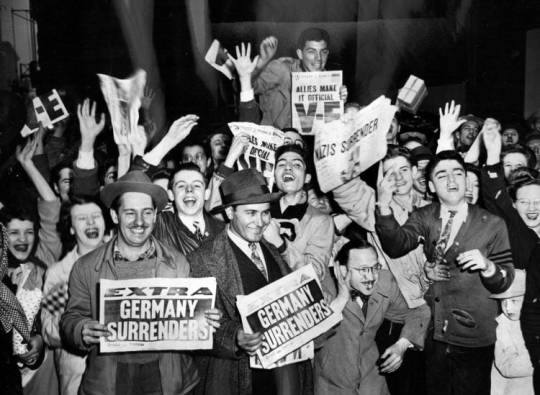
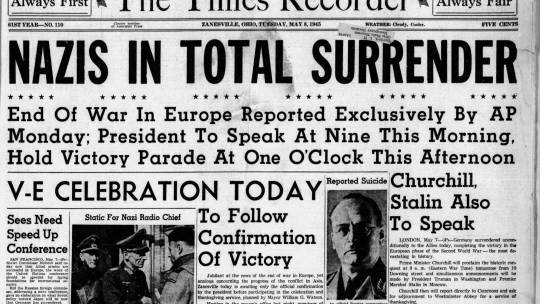
Eleven months after he wrote it, the promise Eisenhower made to his men - the destruction of the German Army, the end of Nazi tyranny in Europe - had finally come true.
It had been five and a half long, blood-soaked years since the war in Europe began, but at long last, Europe was free. It would takes years, even decades, to rebuild from the destruction, but finally, there was a tomorrow to live for.
Eighty years on, we still grapple with their sacrifice, and the choices they made afterwards in the world they built. But because of them, we were given a tomorrow to argue in - and a tomorrow to live for. All because thousands from across the world stepped onto a small, windswept beach, and seared the name of Normandy into history.
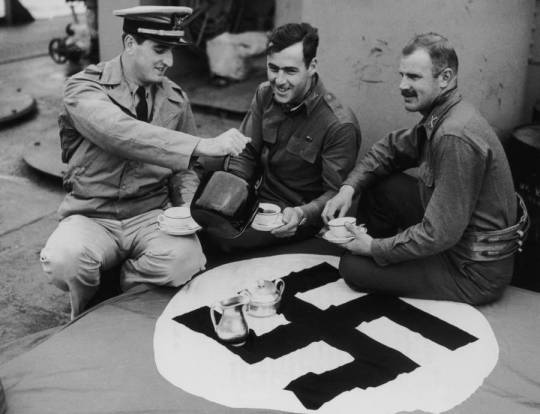

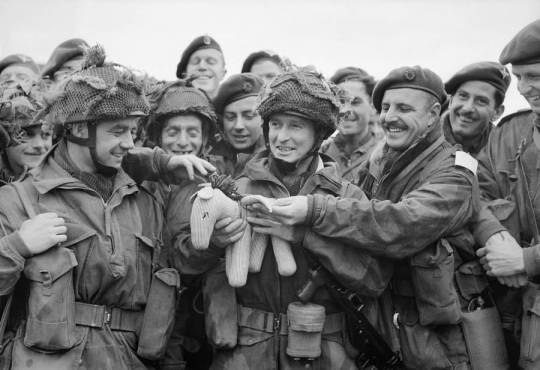
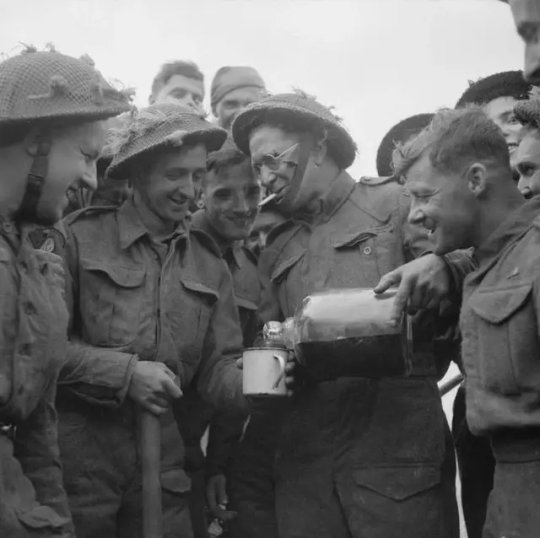
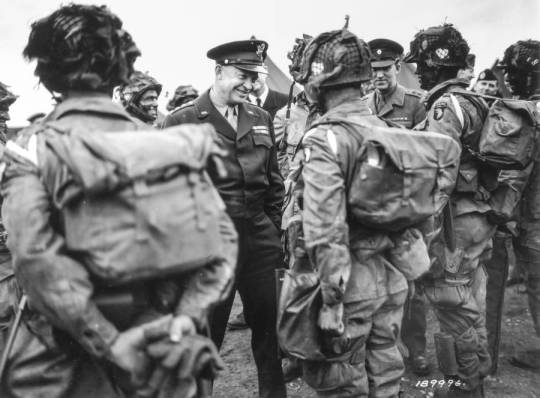
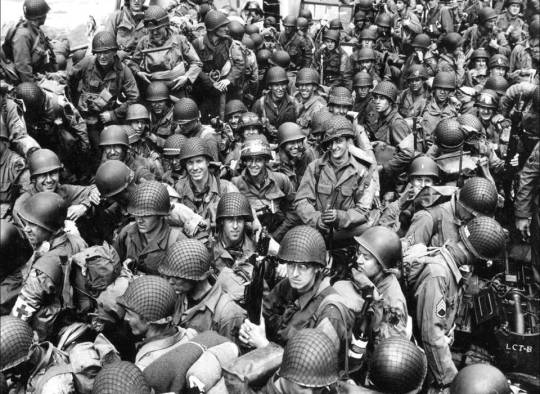
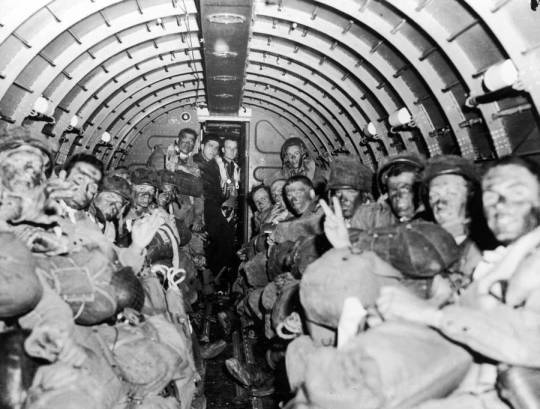
#history#ww2#d day#normandy#tw death mention#will anyone on tumblr care about this? doubtful#but i wrote it anyways because it's been 80 years and that has decided to occupy all of my writing brain cells
8 notes
·
View notes
Text
youtube
#youtube#tumblr#viral#vlogging#daily vlog#facebook#solo#whatsapp#best#trending#instagram#tiktok#travelling#travel#public transport#tourist#tour#tourism#train journey#bus journey#journey#bus vlog#urban bus#bus#bus lover#bangladesh#asia#europe#india#for your page
0 notes
Link
IRCTC Tourism has introduced the most budget friendly Vaishno Devi packages on special 'Swadesh Darshan Tourist Train'. Apart from Vaishno Devi, this tour will also cover Haridwar, Rishikesh and Amritsar. These destinations not only hold religious significance but also offer sightseeing options at famous tourist places in India.
#TOURIST PLACES IN INDIA#TOURIST TRAIN RIDE#VAISHNO DEVI PACKAGE#BEST TRAIN JOURNEYS#BEST TRAIN TOURS#DEVOTIONAL TOUR PACKAGE
0 notes